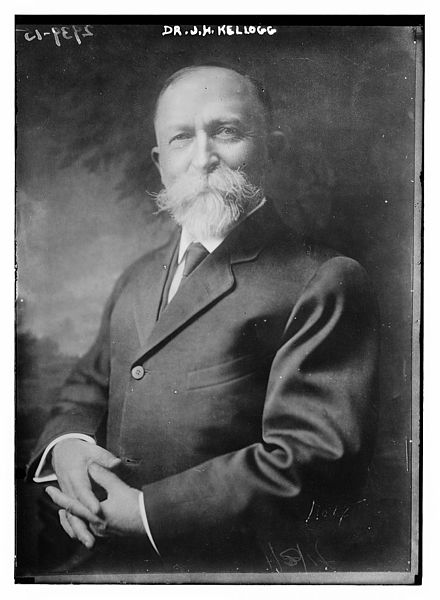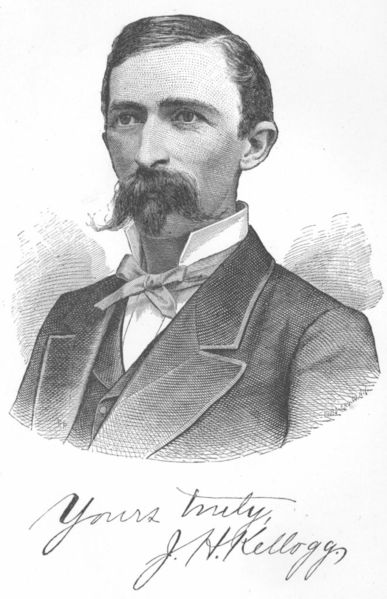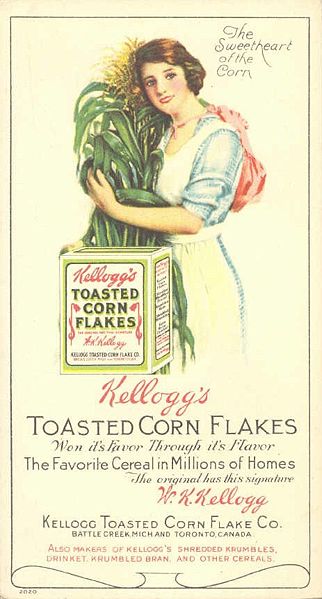<Back to Index>
- Physician John Harvey Kellogg, 1852
- Dramatist Christopher Marlowe, 1564
- Russian Revolutionary Nadezhda Konstantinovna "Nadya" Krupskaya, 1869
PAGE SPONSOR



John Harvey Kellogg (February 26, 1852 – December 14, 1943) was an American medical doctor in Battle Creek, Michigan, who ran a sanitarium using holistic methods, with a particular focus on nutrition, enemas and exercise. Kellogg was an advocate of vegetarianism and is best known for the invention of the corn flakes breakfast cereal with his brother, Will Keith Kellogg. He led in the establishment of the American Medical Missionary College. The College, founded in 1895, operated until 1910 when it merged with Illinois State University.
Kellogg was born in Tyrone, Michigan, to John Preston Kellogg (1806 – 1881) and Ann Janette Stanley (1824 – 1893). Kellogg lived with two sisters during childhood. By 1860, the family had moved to Battle Creek, Michigan, where his father established a broom factory. John later worked as a printer's devil in a Battle Creek publishing house.
Kellogg attended the Battle Creek public schools, then attended the Michigan State Normal School (since 1959, Eastern Michigan University), and finally, New York University Medical College at Bellevue Hospital. He graduated in 1875 with a medical degree. He married Ella Ervilla Eaton (1853 – 1920) of Alfred Center, New York, on February 22, 1879. They did not have any biological children, but raised over 40 children, legally adopting seven
of them, before Ella died in 1920. The adopted children include Agnes
Grace, Elizabeth, John William, Ivaline Maud, Paul Alfred , Robert
Moffatt, Newell Carey, and Harriett Eleanor. Kellogg died in 1943 and
was buried in Oak Hill Cemetery, in Battle Creek, Michigan, along with
his parents, James White and Ellen White, C.W. Post, W.K. Kellogg, his brother and his brother's wife, Uriah Smith, and Sojourner Truth.
While a member of the Seventh day Adventist Church, Dr. Kellogg held a prominent role as a speaker at church meetings. He promoted a practical, common sense religion. Dr. Kellogg expressed his ideas in a creative manner and some members of the church misunderstood what he said. At the Seventeenth Annual Session of the General Conference of Seventh - day Adventists, October 4, 1878, the following action was taken:
"RESOLVED, That in our opinion justice to the doctor and the Institute under his medical charge, demand that he should have the privilege of making his sentiments known, and that he be invited to address those assembled on this ground, upon the harmony of science and the Sacred Scriptures.
"This resolution was unanimously adopted, after which the Conference adjourned to the call of the chair.
"[Note.--In accordance with the foregoing resolution, Dr. Kellogg gave, before a large audience, October 6, an able address on the harmony of science and the Bible, for which the congregation tendered him a vote of thanks.]"
At the turn of the century, his views of indwelling divinity seemed like pantheism to many other Adventist leaders. As an example of these controversial ideas, at the 1901 General Conference he said:
"Some of you have watched a flower winding up a string, a morning glory winding around a string. Perhaps you have seen a vine climbing up a lattice, and you have watched the end coming out, and turning in, back and forth, between the interstices of the lattice. How does the vine know what to do? There is an intelligence that is present in the plant, in all vegetation…
"The heart is a muscle. The heart beats. My arm will contract and cause the fist to beat; but it beats only when my will commands. But here is a muscle in the body that beats when I am asleep. It beats when my will is inactive and I am utterly unconscious. It keeps on beating all the time. What will is it that causes this heart to beat? The heart can not beat once without a command. To me it is a most wonderful thing that a man's heart goes on beating. It does not beat by means of my will; for I can not stop the heart's beating, or make it beat faster or slower by commanding it by my will. But there is a will that controls the heart. It is the divine will that causes it to beat, and in the beating of that heart that you can feel, as you put your hand upon the breast, or as you put your finger against the pulse, an evidence of the divine presence that we have within us, that God is within, that there is an intelligence, a power, a will within, that is commanding the functions of our bodies and controlling them…"
The
issues that had been simmering came to a head in Dec. 1902 when the
Battle Creek Sanitarium, owned by the Seventh - day Adventist Church, was
destroyed by fire. Ellen G. White told Dr. Kellogg not to rebuild it.
He decided to ignore her advice, and was able to gain control of the
board of directors. He wrote a book titled The Living Temple which
he hoped would pay the costs of reconstruction. When the book was
published, it was sharply criticized by Ellen G. White for what she considered to be its many statements of pantheism (God is in
everything). He made all or almost all the corrections she suggested. But it didn't work. In 1907 he was "disfellowshipped."
Kellogg was a Seventh - day Adventist until mid-life and gained fame while being the chief medical officer of the Battle Creek Sanitarium, which was owned and operated by the Seventh - day Adventist Church. The Sanitarium was run based on the church's health principles. Adventists believe in a vegetarian diet, abstinence from alcohol and tobacco, and a regimen of exercise, which Kellogg followed, among other things. He is remembered as an advocate of vegetarianism and wrote in favor of it, even after leaving the Adventist Church. His dietary advice in the late 19th century, which was in part concerned with reducing sexual stimulation, discouraged meat eating, but not emphatically so.
Kellogg was an especially strong proponent of nuts,
which he believed would save mankind in the face of decreasing food
supply. Though mainly renowned nowadays for his development of corn flakes, Kellogg also patented a process for making peanut butter and invented healthful, "granose biscuits."
At the Battle Creek Sanitarium, Kellogg held classes on food preparation for homemakers. Sanitarium visitors engaged in breathing exercises and mealtime marches to promote proper digestion of food throughout the day. Because Kellogg was a staunch supporter of phototherapy, the sanitarium also made use of artificial sunbaths.
Kellogg made sure that the bowel of each and every patient was plied with water, from above and below. His favorite device was an enema machine that could rapidly instill several gallons of water in a series of enemas. Every water enema was followed by a pint of yogurt — half was eaten, the other half was administered by enema, “thus planting the protective germs where they are most needed and may render most effective service." The yogurt served to replace the intestinal flora of the bowel, creating what Kellogg claimed was a squeaky clean intestine.
Kellogg believed that most disease is alleviated by a change in intestinal flora; that bacteria in the intestines can either help or hinder the body; that pathogenic bacteria produce toxins during the digestion of protein that poison the blood; that a poor diet favors harmful bacteria that can then infect other tissues in the body; that the intestinal flora is changed by diet and is generally changed for the better by a well balanced vegetarian diet favoring low protein, laxative, and high fiber foods; and that this natural change in flora could be sped by enemas seeded with favorable bacteria, or by various regimens of specific foods designed to heal specific ailments.
Kellogg was a skilled surgeon, who often donated his services to indigent patients at his clinic. Although generally against unnecessary surgery to treat diseases, he did advocate circumcision, allegedly to prevent masturbation.
He had many notable patients, such as former president William Howard Taft, composer and pianist Percy Grainger, arctic explorers Vilhjalmur Stefansson and Roald Amundsen, world travellers Richard Halliburton and Lowell Thomas, aviator Amelia Earhart, economist Irving Fisher, Nobel prize winning playwright George Bernard Shaw, actor and athlete Johnny Weissmuller, founder of the Ford Motor Company Henry Ford, inventor Thomas Edison, and actress Sarah Bernhardt.
John Kellogg and his brother Will Keith Kellogg started the Sanitas Food Company to produce their whole grain cereals around 1897, a time when the standard breakfast for the wealthy was eggs and meat, while the poor ate porridge, farina, gruel, and other boiled grains. John and Will later argued over the recipe for the cereals (Will wanted to add sugar to the flakes). So in 1906, Will started his own company, the Battle Creek Toasted Corn Flake Company, which eventually became the Kellogg Company, triggering a decades long feud. John then formed the Battle Creek Food Company to develop and market soy products.
The Kelloggs did not invent the concept of the dry breakfast cereal. That honor belongs to Dr.James Caleb Jackson, who created the first dry breakfast cereal in 1863, which he called, "Granula." A patient of John's, Charles William Post, would eventually start his own dry cereal company, Post Cereals, selling a rival brand of corn flakes. Dr. Kellogg later would claim that Charles Post stole the formula for corn flakes from his safe in the Sanitarium office.
As an advocate of sexual abstinence, Kellogg devoted large amounts of his educational and medical work to discouraging sexual activity, on the basis of dangers both scientifically understood so at the time, as in sexually transmissible diseases; and those taught by the Seventh - day Adventist Church. He set out his views on such matters in one of his larger books, published in various editions around the turn of the 20th century under the title Plain Facts about Sexual Life and later Plain Facts for Old and Young. Some of his work on diet was influenced by his belief that a plain and healthy diet, with only two meals a day, among other things, would reduce sexual feelings. Those experiencing temptation were to avoid stimulating food and drinks, and eat very little meat, if any. Kellogg also advocated hydrotherapy and stressed the importance of keeping the colon clean through yogurt enemas. He warned that many types of sexual activity, including many "excesses" that couples could be guilty of within marriage, were against nature, and therefore, extremely unhealthy. He drew on the warnings of William Acton and expressed support for the work of Anthony Comstock. He appears to have followed his own advice; it has been suggested he worked on Plain Facts during his honeymoon.
He was an especially zealous campaigner against masturbation;
this was an orthodox view during his lifetime, especially the earlier
part. Kellogg was able to draw upon many medical sources' claims such
as "neither the plague, nor war, nor smallpox, nor similar diseases,
have produced results so disastrous to humanity as the pernicious habit
of onanism,"
credited to one Dr. Adam Clarke. Kellogg strongly warned against the
habit in his own words, claiming of masturbation related deaths "such a
victim literally dies by his own hand," among other condemnations. He
felt that masturbation destroyed not only physical and mental health,
but the moral health of individuals as well. Kellogg also believed the
practice of "solitary - vice" caused cancer of the womb, urinary
diseases, nocturnal emissions, impotence, epilepsy, insanity, and
mental and physical debility; "dimness of vision" was only briefly
mentioned. Kellogg
worked on the rehabilitation of masturbators, often employing extreme
measures, even mutilation, on both sexes. He was an advocate of
circumcising young boys to curb masturbation and applying phenol (carbolic acid) to a young woman's clitoris. In his Plain Facts for Old and Young, he wrote
“ A remedy which is almost always successful in small boys is circumcision, especially when there is any degree of phimosis.
The operation should be performed by a surgeon without administering an
anesthetic, as the brief pain attending the operation will have a
salutary effect upon the mind, especially if it be connected with the
idea of punishment, as it may well be in some cases. The soreness which
continues for several weeks interrupts the practice, and if it had not
previously become too firmly fixed, it may be forgotten and not resumed. ”
and
| “ | In females, the author has found the application of pure carbolic acid [phenol] to the clitoris an excellent means of allaying the abnormal excitement. | ” |
He also recommended, to prevent children from this "solitary vice", bandaging or tying their hands, covering their genitals with patented cages, sewing the foreskin shut and electrical shock. In his Ladies' Guide in Health and Disease, for nymphomania, he recommended
| “ | Cool sitz baths; the cool enema; a spare diet; the application of blisters and other irritants to the sensitive parts of the sexual organs, the removal of the clitoris and nymphae... | ” |
Kellogg was outspoken on his beliefs on race and segregation, in spite of the fact that he himself adopted a number of black children. In 1906, together with Irving Fisher and Charles Davenport, Kellogg founded the Race Betterment Foundation, which became a major center of the new eugenics movement in America. Kellogg was in favor of racial segregation and believed that immigrants and non-whites would damage the gene pool.
Kellogg had a long personal and business split with his brother after fighting in court for the rights to cereal recipes. The Foundation for Economic Education records that the nonagenarian J.H.K. prepared a letter seeking to reopen the relationship, but that his secretary decided her employer had demeaned himself in it and refused to send it. The younger Kellogg did not see it until after his brother's death.